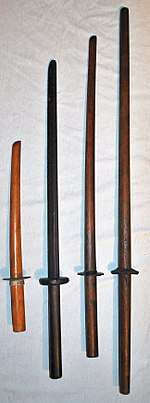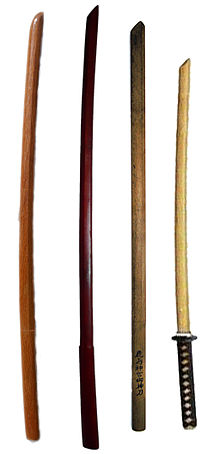Bokken
A bokken (木剣, bok(u), "wood", and ken, "sword") (or a bokutō 木刀, as they are instead called in Japan) is a Japanese wooden sword used for training in kenjutsu. It is usually the size and shape of a katana, but is sometimes shaped like other swords, such as the wakizashi and tantō. Some ornamental bokken are decorated with mother-of-pearl work and elaborate carvings. Sometimes it is spelled "boken" in English.

Bokken are traditionally composed of red oak or white oak, although any hard wood can be used. In comparison, practice swords made of flexible, soft wood such as bamboo are referred to as a shinai.
History
It is hard to determine precisely when the first bokken appeared due to secrecy in ancient martial arts training and loose record-keeping. While various mock weapons were surely used during the earlier periods of Japanese history, usage of a bokken in their modern form first emerged during the Muromachi Period (1336–1600) for the training of samurai warriors in the various ryūs (schools of martial arts and swordsmanship) of the era.[1] If a malleable steel katana is repeatedly used, it can easily become nicked and the edge flawed, eventually leading to a broken expensive sword. Bokken are safer than fighting with real swords, and are considerably more durable; a wielder can make contact with other trainee's swords with little fear of damage.[2]
While bokken are safer for sparring and practice then katanas, they are still lethal weapons in the hands of trained users. A famous legend to this effect exists involves Miyamoto Musashi, a ronin known to fight fully armed foes with only one or two bokkens. According to the story, he agreed to a duel with Sasaki Kojiro at the early morning on Ganryūjima island, a tiny sandbar between Kyushu and Honshu. Musashi overslept the morning of the duel, however, and hastily made his way to the duel late. He carved a crude bokken from an oar with his knife while traveling on a boat to the duel.[3] At the duel, Sasaki was armed with his large nodachi, yet Musashi crushed Sasaki's skull with a single blow from his bokken, killing him. While many elements of the story are likely apocryphal, the potential danger of a bokken from the legend is real.[1]
Before the Meiji era, bokken were very likely manufactured by woodworkers not specialized in bokken manufacture. At the beginning of the 20th century bokken manufacture started more formally, mainly in Miyakonojo (Kyushu region). The last four remaining bokken workshops of Japan are still located in Miyakonojo.
The "standard bokken", mostly used in Kendo, Iaido, and Aikido was created by master Aramaki in collaboration with the All Japan Kendo Federation in the 1950s and was the first standardized bokken ever created.[4]
Usage

The bokken is used as an inexpensive and relatively safe substitute for a real sword in several martial arts such as aikido, kendo, iaido, kenjutsu and jodo. Its simple wooden construction demands less care and maintenance than a katana. In addition, training with a bokken does not carry the same mortal risk associated with that of a sharp metal sword, both for the user and other practitioners nearby. While its use has several advantages over use of a live edged weapon, it can still be deadly, and any training with a bokken should be done with due care. Injuries occurring from bokken are very similar to those caused by clubs and similar battering weapons and include compound fractures, ruptured organs, and other such blunt force injuries. In some ways, a bokken can be more dangerous as the injuries caused are often unseen and inexperienced practitioners may underestimate the risk of harm. It is not a sparring weapon, but is intended to be used in kata and to acclimate the student to the feel of a real sword. For sparring, a bamboo shinai is typically used instead for obvious safety reasons.
In 2003, the All Japan Kendo Federation (AJKF) introduced a set of basic exercises using a bokuto called Bokuto Ni Yoru Kendo Kihon-waza Keiko-ho. This form of practice is intended primarily for kendo practitioners up to Nidan ranking, but can be beneficial for all kendo students.[5]
Suburito are bokken designed for use in suburi. Suburi, literally "bare swinging," are solo cutting exercises. Suburito are thicker and heavier than normal bokken and users of suburito must therefore develop both strength and technique. Their weight makes them unsuitable for paired practice and solo forms. Miyamoto Musashi's bokken made of an oar in his legendary duel with Sasaki Kojiro was presumably a suburi-sized bokken.
As late as 2015, bokken were issued to the Los Angeles Police Mounted Unit for use as batons.[6][7]
Types
Bokken can be made to represent any style of weapon required such as nagamaki, no-dachi, yari, naginata, kama, etc. The most widely used styles are:
- daitō or tachi (katana-sized), long sword
- shoto or kodachi or wakizashi bo, short sword, (wakizashi-sized)
- tantō bo (tantō-sized)
- suburito can be made in daitō and shoto sizes
Additionally, various koryu (traditional Japanese martial arts) have their own distinct styles of bokken which can vary slightly in length, tip shape, or in whether or not a tsuba (hilt guard) is added.
The All Japan Kendo Federation specify the dimensions of bokken for use in the modern kendo kata, called Nippon kendo kata.[8]
- Tachi: Total length, approx. 102 cm; tsuka (handle) approx. 24 cm.
- Kodachi: Total length, approx. 55 cm; tsuka (handle) approx. 14 cm.
Bokken are traditionally composed of red oak or white oak, with white oak varieties being slightly more expensive and prestigious. Other common tree varieties used included ebony, biwa, and sunuke in Japan, and hickory, persimmon, ironwood, and walnut for trees native to the Americas. Biwa trees were used at least partially due to a folk superstition that wounded inflicted by biwa wood would never heal.[1]
In fiction
Bokken has been depicted in film, manga, anime, and comic books.
- In the film The Last Samurai, the bokken is seen in multiple instances. In one scene a group of children is playing/sparring with them. Later in the film, Nathan Algren (played by Tom Cruise) is seen undergoing sword training with a bokken.
- In Hiroyuki Takei's manga and anime series Shaman King, Umemiya Ryunosuke possesses a wooden sword and uses it as his main weapon, and is accordingly known as "Wooden Sword" Ryu.
- In the anime Outlaw Star Twilight Suzuka utilizes a bokken with immense skill and is able to use it more efficiently than an actual sword.
- In the anime Demon City Shinjuku, the hero Kyoya Izayoi wields a bokken which he can infuse with spiritual energy.
- In the Wolverine limited series (1982) by Chris Claremont and Frank Miller, Wolverine is nearly killed by Shingen Yashida, using a bokken to deliver nerve strikes.
- In the anime and the manga, Gin Tama, the protagonist, Gintoki Sakata, uses a bokken as his main weapon. His skills with it are powerful enough to overpower even real swords. Other characters, especially Shinpachi Shimura, are frequently seen using bokken to practice.
- In the anime and manga, Rurouni Kenshin, Kamiya Kaoru uses a bokken as her main weapon until it breaks.
- In the anime and light novel series, Toradora!, Aisaka Taiga can be seen wielding a bokken.
- In the anime and manga, Ranma ½, Kuno Tatewaki wields a bokken and occasionally a shinai.
- In the anime and manga, Highschool of the Dead, Saeko Busujima initially wield a bokken. She replaces it with a katana later in the series.
- In the anime and manga, Hunter x Hunter, Kurapika wields two wakizashi-sized bokken attached via a rope. In the 1999 anime, the bokken is actually a sheathed sword.
- In the anime and manga Demon Slayer: Kimetsu no Yaiba, the character of Sabito is seen wielding a wooden bokken in his first appearance and in his fight against Tanjiro.
References
- Lowry, Dave (1986). Bokken: Art of the Japanese Sword. Ohara Publications. p. 21–27. ISBN 978-0-89750-104-0.
- Ratti, Oscar; Westbrook, Adele (1991). Secrets of the Samurai; A Survey of the Martial Arts of Feudal Japan (1st pbk. ed.). Rutland, Vt.: C.E. Tuttle Co. p. 272. ISBN 978-0-8048-1684-7.
- Wilson, William Scott (2004). The Lone Samurai: The Life of Miyamoto Musashi (1st ed.). Tokyo: Kodansha International. p. 19. ISBN 9784770029423.
- Seido - Budo Equipment & Practice in Japan (2017-10-05), [Interview] Aramaki Yasuo - Bokken Manufacture 3rd Generation Craftsman (Part 1/2), retrieved 2018-05-03
- "全日本剣道連盟オンライン・ショップ:剣道書籍". Zenkenren-shop.com. Retrieved 2015-11-12.
- "LAPD Equipment - Los Angeles Police Department". Lapdonline.org. Retrieved 2015-11-12.
- Edwards, Holly (August 6, 2000). "Mounted Patrols Train for Handling Unrest at Convention". Los Angeles Daily News. p. N3.
- "AJKF Online-shop : English version". Zenkenren-shop.com. Retrieved 2015-11-12.
External links
| Wikimedia Commons has media related to Bokken (bokuto). |
- A discussion of different woods with regard to bokken design, focusing particularly on durability
- Information about making or selecting a bokken
(Wayback Machine copy)